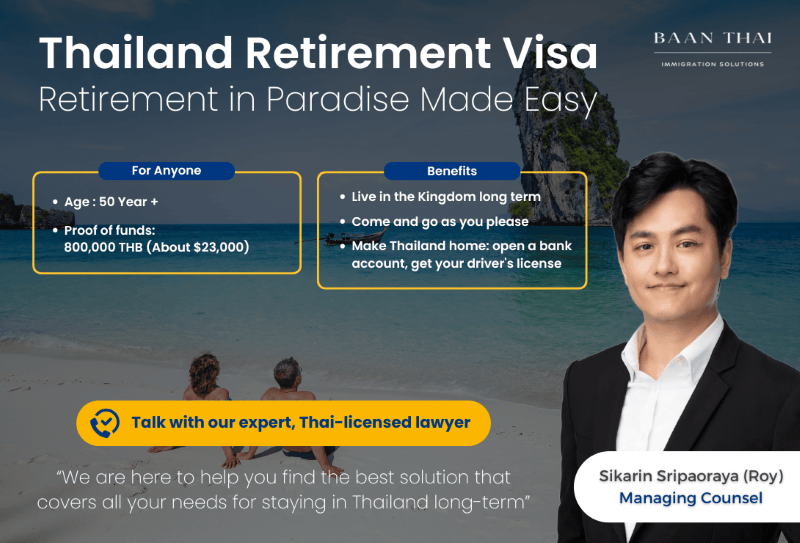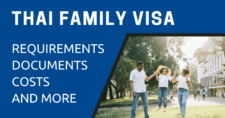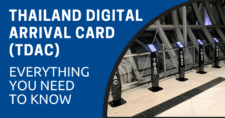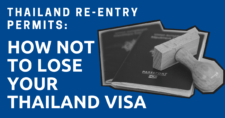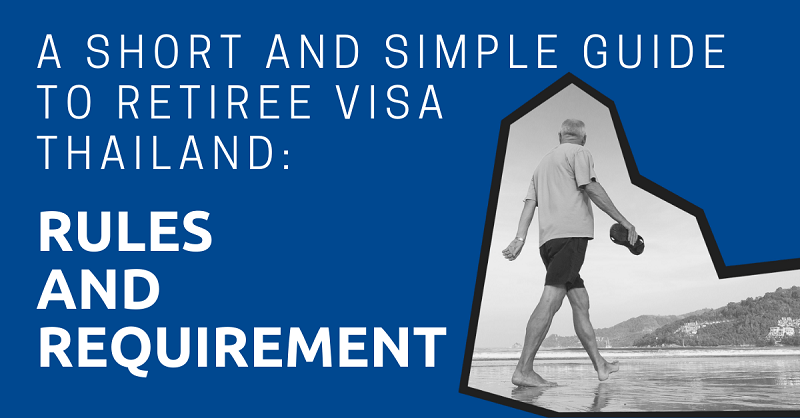
Have you been thinking about retiring in Thailand? Wondering what options you have?
In short, Thailand has many types of retirement visas. Each option has different requirements. For example, you don’t need health insurance if you apply for a non-immigrant O visa. On the other hand, if you go for a non-immigrant OA visa, then you need to get health insurance.
In this post, you’ll find out all available options for Thailand retirement visas, what financial requirements you need to meet, which documents you need to present, and the step-by-step application process.
*Check out ExpatDen Premium and gain access to hundreds of exclusive pieces of content that will help you retire in Thailand smoothly and peacefully. With it, you will learn how to open a bank account in Thailand with a tourist visa, how to get affordable yet quality healthcare, how to negotiate your rent down by 40%, and much more.
"*" indicates required fields
Disclaimer: This article may include links to products or services offered by ExpatDen's partners, which give us commissions when you click on them. Although this may influence how they appear in the text, we only recommend solutions that we would use in your situation. Read more in our Advertising Disclosure.
Contents
- Key Takeaways
- What is it?
- Options
- Requirements
- Required Document
- Application Process
- Where to Apply
- How to Show Proof of Funds
- What if You Can’t Open a Bank Account in Thailand?
- Single-Entry or Multiple-Entry?
- Visa Restrictions
- Other Retirement Visas
- Frequently Asked Questions
- Can I Change a Tourist Visa to a Retirement Visa within Thailand?
- What's the Easiest Way to Get a Retirement Visa?
- When Should I Renew My Retirement Visa?
- Should I Get a Marriage Visa or a Retirement Visa?
- Can I Add a Dependent to My Retirement Visa?
- I applied for an E-Visa through the Thailand eVisa website many weeks ago but haven’t heard back yet. I also have an upcoming flight. What should I do?
- I applied for the visa through the eVisa website and my application is being processed. Can I come to Thailand during that time?
- Can I Change from Non-OA to Non-O in Thailand?
- Can I Switch from the THB 800,000 Method to a Monthly Income of THB 65,000?
- Need Help Applying for a Thailand Retirement Visa?
(And How It’s Costing Them)
Most expats throw money away, get lost in red tape, and miss the local hacks that make life easier and cheaper. ExpatDen Premium gives you the secrets seasoned expats use to save, earn, and thrive beyond the basics, saving you thousands and opening doors you didn’t even know existed.
Here’s what’s inside:
- Housing Hacks: Slash your rent by 40% or more - because the locals are laughing at what you’re paying.
- Banking Mastery: Stop wasting on fees and get top exchange rates. Why give your money away?
- Healthcare for Local Prices: Quality treatment without the expat price tag.
- Visa and Legal Shortcuts: No more bureaucratic nightmares. Get the visa and residency secrets that others pay their lawyer dearly for.
- Deep Discounts: Find the savings locals rely on for groceries, dining, and more.
If you’re serious about making Thailand work for you, join ExpatDen Premium and make Thailand work for you.
Key Takeaways
- Thailand has several retirement visa options, with different requirements depending on the type you choose.
- The Non-immigrant O visa (or Non-O for short) is often the best choice since it doesn’t require health insurance.
- There are two main requirements for the Non-O visa: you need to be at least 50 years old and meet the financial requirements.
- To get the Non-O visa, you need to have THB 800,000 or equivalent in your bank account or show a monthly income of THB 65,000.
- The easiest way to get a Non-O visa is to apply from outside of Thailand. Otherwise, you need a Thai bank account, which is very hard to get unless you have a long-term visa.
- The Non-O visa initially gives you a 90-day stay in Thailand. After that, you can extend it to a one-year visa in Thailand.
- Each Thai embassy, consulate, or immigration office may require different documents. Confirm with them before preparing paperwork.
What is it?
The Thai retirement visa lets qualified retirees who are at least 50 years old and meet the specific requirements to retire in Thailand.
The duration of stay depends on the type of retirement visa you have, which can be found later in the article. Also, with a retirement visa, you can keep extending your stay in Thailand for 1 to 10 years as long as you meet the requirements.
Options
There are mainly three types of retirement insurance:
- Non-immigrant O: It’s the most popular type of retirement visa since there’s no health insurance requirement. You initially get a 90-day stay. After that, you can come to Thailand and extend your stay for 1 year.
- Non-immigrant OA: With this visa, it initially allows you to stay in Thailand for 1 year. However, you need to have health insurance to apply for or extend your visa extension.
- Non-immigrant OX: It’s known as a 10-year retirement visa, available to certain nationalities. Read our specific guide to the non-immigrant OX visa section below for more information.
In our opinion, unless you are eligible for the Non-immigrant OX visa, getting a Non-immigrant O visa is the best option. It has the same requirements as a Non-immigrant OA, but you don’t need health insurance.
Requirements
To get a retirement visa in Thailand, there are five main requirements:
- age
- financial requirement
- health insurance
- criminal record
- prohibitive disease
Let’s take a look at each one individually.
Please note that the requirements for each nationality can be different and subject to change. Certain Thai embassies may also have different requirements.
Age
To apply for a retirement visa in Thailand, you must be at least 50 years old.
Financial Requirements
To qualify for non-immigrant O or OA visa, you’ll need to show one of these three financial documents:
- copies of your bank statements showing a deposit of the amount equal to and not less than 800,000 baht in your bank account or
- copies of bank statement showing income of not less than 65,000 baht per month or
- a combination of a deposit account and a monthly income totaling at least 800,000 baht
If you go with THB800,000 option, please note that the money need to be in your bank account at least 2 months before the visa application or extension.
Health Insurance
If you apply for a non-immigrant OA visa, you need to have health insurance with THB3,000,000 coverage. It can be from a Thai insurance company or an international company, as long as it meets the minimum requirements.
In my opinion, there are two main options:
- Affordable option: You can get the Luma Long Stay Care plan as an affordable health insurance option that meets visa requirements. The plan comes with a high deductible of THB 20,000 to THB 200,000, which is suitable for expensive healthcare. You can read our review to find out more.
- Comprehensive option: If you need something more comprehensive, check out the senior plan from Cigna Global. It comes with US$500,000 in coverage and should be sufficient for any hospital in Thailand.
Tip: Please note that insurance requirements keep changing regularly. The best way to confirm is to contact the Thai embassy, immigration office, or Thai consulate where you are applying for the visa.
Find out more: A Guide to Thailand’s Mandatory Health Insurance Rules for Retirees (2025)
Criminal Record
You should have no criminal record in your home country and in Thailand. You can get it from your local police station.
Required Document
When it comes to applying for any type of visa in Thailand, including the Thailand retirement visa, documents are key. As long as you prepare the documents that the immigration officer wants to see, your chances of getting your visa approved are high.
Here are the documents you need to apply for any type of Thailand retirement visa.
- an application form, which can be picked at the immigration office
- passport with at least six months validity and two blank pages on both side.
- 4 cm x 6 cm photos taken in the last six months
- an updated bank passbook
- a bank letter confirming your funds not less than two months from the date of application*
- a health insurance certificate (only required for non-immigrant OA visa and non-immigrant OX visa)
- a police/background check certificate
If you apply from within Thailand, you may need additional documents, including:
- A copy of your passport, including the information page and all pages related to Thailand visas, such as the visa stamp, extension of stay, and eVisa (if you have it).
- A copy of TM 30 (residence registration)
- A Google map of your house printed on A4 with latitude and longitude
Normally, you will need two copies of each document. You should also sign all copies and include your name on them. Sometimes, you may also need two copies of every page in your bankbook as well as your rental contract.
Each immigration office, Thailand Consulate, and Thailand Embassy may require different documents. Therefore, you should contact them in advance to determine the exact documents needed.
Application Process
There’s a step-by-step guide to applying for a Non-immigrant O visa based on retirement. If you wish to apply for other types of visas, the whole process is quite similar—you just need to select a different visa during the application on the Thai eVisa site.
Also, the steps below are for those applying from outside of Thailand via the Thailand eVisa website for a non-immigrant O visa based on retirement. This is our most recommended way to get a visa.
Applying within Thailand is becoming much harder, as you now need to have a Thai bank account, which is almost impossible to get unless you already hold a long-term visa.
Start Your Application via the Thailand eVisa Website
The first step is to apply online via the Thai eVisa website:
- Go to the Thai eVisa website and create your account
- Sign in and apply for a visa
- Choose Visa Type as “Non-Immigrant Visa”
- Choose the Purpose of Visit as “Retirement (pensioner aged 50 or above with state pension…)”
- Choose Number of Entries as “Single”
- Choose your local Thai embassy or consulate that will process your visa
- Upload all required paperwork
After that, it will take around 7 to 15 business days for the Thai embassy or consulate to process your visa. If you haven’t heard from them, you can send an email to follow up.
Once your visa is approved, you can fly to Thailand. Initially, the visa allows you to stay for 90 days only.
Complete Your Visa Application in Thailand
Once you are in Thailand, here’s what you need to do:
- Immediately open a Thai bank account and transfer THB 800,000 into it, since the money needs to be in your account for at least 2 months before you can extend your visa. Kasikorn Bank, Bangkok Bank, SCB, and Krung Thai Bank are our top choices as they have the most branches throughout Thailand
- File TM30 in the area where you want to extend your retirement visa
- Gather all paperwork
- On the day you want to extend your visa, go to a bank first to get a bank certificate. After that, go to your local immigration office to extend your visa
- If the paperwork is correct, you will get an extension of stay stamp in your passport, granting you a 1-year stay in Thailand
Keep Your Thailand Retirement Visa Active
After you get the Thailand Retirement Visa, there are a few things you need to do to keep your visa active:
- Maintain your bank balance so it never drops below THB 400,000
- Keep the 3+2 months rule:
- Don’t let your balance drop below THB 800,000 for three months after you extend your visa
- Your balance must be at least THB 800,000 for two months before your next extension
- If you are on a single-entry visa, always apply for a re-entry permit before leaving Thailand
- Complete a 90-day notification report (Read this article to find out more)
Keep Extending Your Visa
Since the retirement visa (non-immigrant O and non-immigrant OA) is only valid for one year, you need to visit your local immigration office every year to extend your visa. Some people refer to this as “renewing” your visa.
When your visa is about to expire, you’ll need to extend it at any of the immigration offices in Thailand. The process and paperwork are the same as when you first applied.
There are two things you should keep in mind:
- your bank balance needs to be more than THB800,000 at least two months before the visa renewal.*
- If you come to Thailand with a Non-OA Visa, you need health insurance to renew your retiree visa. On the other hand, if you come to Thailand with a Non-O visa, then you don’t need health insurance.
The whole process is similar to when you extend your visa in Thailand for the first time. However, depending on where you go, you may need to show additional documents, such as:
- Some photos of you standing in front of your property, with the room number visible
- A printed Google Map address of your property, with latitude and longitude
So, the best way to confirm the list of documents you need is to ask your immigration office for a list of required documents.
Once you are done, you will get a 1-year extension of stay permit based on retirement stamp on your passport.
Where to Apply
You can apply for a retirement visa either in your home country (in some cases) or in Thailand.
Outside Thailand
If you’re applying for your retirement visa outside of Thailand, in general, you will need to apply through the Thailand eVisa website, as mentioned above.
If not, you’ll need to visit your Thai embassy or consulate in person and submit all of the paperwork listed above. Then, pick up your passport with the Thai visa stamp and fly to Thailand to complete the application.
Inside Thailand
If you start your application in Thailand, in most cases, you need to apply for a non-immigrant O visa before extending it to stay in Thailand for one year.
You’ll be given 90 days in the kingdom, and after your first 60 days, you can extend it.
However, the biggest challenge of applying for a retirement visa inside Thailand is that you need a Thai bank account. Without a long-term visa, it’s almost impossible to open one, unless you use a visa agent.
Assuming you have a Thai bank account and meet the financial requirements, here’s what you need to do:
- Walk into your local immigration office.
- Go to an information desk to get your queue number and have your documents checked.
- Proceed to an immigration office’s counter when your queue number is called.
- Prepare for a short interview. The immigration office may also inquire about your job prior to retirement.
- If everything is satisfactory, the immigration officer will accept your documents and inform you of when you can collect your visa.
- The processing time is approximately 15 business days, although this can vary depending on the specific immigration office, consulate, or embassy.
Please note that sometimes an immigration office may request a Thai name and phone number for reference. Therefore, it’s best to prepare this information in advance.
(Advertisement)
Bangkok
If you are in Bangkok, you can go to the Division 1 Immigration Office in Bangkok.
Here’s the Google Maps link to Division 1 Immigration Office in Bangkok. It’s known as Chaeng Watthana office or CW in short.
Here’s the physical address:
- 120 Thanon Chaeng Watthana, Khwaeng Thung Song Hong, Khet Lak Si, Krung Thep Maha Nakhon 10210
Just bring with you all of the documents listed in this section and the above requirements section.
Chiang Mai
If you are in Chiang Mai, you can go to Chiang Mai Immigration Office. It’s located near Chiang Mai International airport. Here’s the physical address: 71 Sanaam Bin Road, Mueang Chiang Mai District, Chiang Mai 50200, Thailand.
Phuket
If you are in Phuket, there’s Phuket Immigration Office. It’s conveniently located in the center of Phuket. Here’s the address: 482 Phuket Road, Talad Yai, Muang, Phuket 83000 Thailand.
There’s also another immigration office in Patong. But that’s mainly for a short-term stay such as extending your tourist visa or visa exemption, or a 90-day notification.
Other
There are 58 immigration offices throughout Thailand. Here’s a map to all of them. Please note that it’s best to apply or renew your retiree visa on your local immigration office. If you go to another immigration office, they may not allow it.
How to Show Proof of Funds
Showing proof of funds can be a headache for retirement visa applicants. This is also the main challenge for many people.
THB800,000 Route
When applying for a retirement visa outside of Thailand, you can contact your bank and ask for a statement showing that you have at least THB800,000 equivalent in your local currency.
After you get your visa and come to Thailand, the most straightforward way to show adequate funds in Thailand is to open a bank account in the country and leave THB800,000 there for two months before applying for or extending your visa.
*Note that as mentioned above, the required balance differs between each type of retirement visa.
Then, on the day you want to extend your visa, visit the bank branch and ask for a 12-month bank statement. It costs a few hundred baht and you should be able to pick it up within an hour.
However, there are a few things you should keep in mind:
- The 3+2 months rule, as mentioned earlier
- When depositing the money into your account, make sure that it comes from abroad and that the transfer code in your bank transaction shows it’s from an international transfer. Otherwise, you need to ask for a “credit advice” from your bank to prove that it’s money from abroad
- The bank letter is valid for 7 days
- The balance in your bank book must match that of the bank letter. This means that after you obtain a bank letter, you MUST NOT deposit or withdraw money from your bank account
THB65,000 Route
If you don’t want to leave that much money in your Thailand bank account, then there’s another route you can take. You can show that you have at least THB65,000 going into your bank account every month.
You do it by sending money to your bank account in Thailand each month. If you want to save on transfer fees and exchange rates, you can open a Wise Multi-Currency Account, convert your local currency to Thai Baht when rates are good, and then transfer into Thailand.
While it’s doable in theory, in practice, it’s a challenge.
Many immigration offices in Thailand, including those in Jomtien and Pattaya, also want to see a pension certificate or an income affidavit from your embassy if you want to go with this route. And it isn’t easy to get right now.
Some embassies, such as the US Embassy, no longer issue it.
Therefore, if possible, go with the THB800,000 route.
Tip: If you want to be hassle-free with the financial requirement, after opening a Thai bank account, transfer the THB800,000 and just leave it there. Then, open another account and use it for your daily expenses instead.
What if You Can’t Open a Bank Account in Thailand?
It can be a challenge to open a bank account in Thailand if you’re here on a tourist visa.
However, as long as you have a retirement visa, you shouldn’t have any problems opening a bank account in the country.
Therefore, it’s a good idea to get a retirement visa from your home country. You can use a financial statement from your home bank as proof of your income when you apply for your retirement visa at a Thai embassy in your home country.
Once you’re in Thailand, you can open a bank account and manage your funds as mentioned in the above section.
Single-Entry or Multiple-Entry?
When applying for a retirement visa, you’ll have two options when getting your retirement visa.
Single-entry
A single-entry is for anyone who doesn’t plan to leave Thailand.
If you do, whether for leisure or in an emergency, you must apply for a re-entry permit. Otherwise, your visa will be cancelled immediately after you exit Thailand.
A single-entry visa is recommended when you first apply for the visa from outside of Thailand.
Multiple-entry
A multiple-entry visa lets you leave and enter Thailand as you wish.
So if you know that you’re going to come and go quite often while living in Thailand, your best bet is to get a multiple-entry visa from the start.
Visa Restrictions
Retirement visa holders are prohibited from engaging in any type of work.
Other Retirement Visas
Here are a few other options you have if retiring in Thailand is in your radar.
Ten-year Retirement Visa (O-X)
The ten-year Thai retirement visa lets affluent retirees from 14 countries stay in Thailand for up to ten years.
Here are those countries: Australia, Canada, Denmark, Germany, Finland, France, Italy, Japan, Netherlands, Norway, Sweden, Switzerland, United Kingdom, and United States.
It is renewable every ten years.
The requirements for this visa are a little different. You’ll need the following to qualify for non-immigrant OX ten-year visa:
- 3 million baht in a bank account, untouched for at least three months from your application date or
- 1.2 million baht in a bank account and 100,000 baht monthly income. After you are in Thailand, your Thai bank account should have at least 3 million baht untouched within a year.
- health insurance that provides you with at 400,000 baht IPD coverage and 40,000 baht OPD coverage (non-optional)
The application process is the same as applying for a non-immigrant O visa.
Thailand Privilege Card (Elite Visa)
The Thailand Privilege Card program, previously known as the Elite Visa, isn’t technically a retirement visa. But it’s a valid option if you want to retire in Thailand long-term and avoid visa runs and extensions.
Depending on the membership package, you can stay in Thailand for five to 20 years and don’t need to keep having 800,000 baht in your bank account all the time.
The best thing about the Thailand Privilege Card is that it significantly decreases the time and headaches of dealing with paperwork and immigration officers, and it keeps you updated with the everchanging retirement visa requirements.
Many retirees now go for this route even if they are eligible for the retirement visa.
However, this program is not available to everyone, as there is a membership fee involved. The fee starts at 900,000 baht for a 5-year visa, and for a 15-year visa, it is 2,500,000 baht.
To find out more, read our Thailand Privilege Card review.
Marriage Visa
If you’re married to a Thai national, you can get a non-immigrant visa O based on marriage from the Thai embassy nearest to you or in Thailand at an immigration office. The financial requirements are a little easier to manage.
However, while the financial requirements are lower, it comes with another hassle: showing proof of the relationship. It’s not just about presenting your marriage certificate. You also need to provide photo evidence.
Additionally, depending on where you live, an immigration officer may randomly visit your home to verify that you are a real couple. They may also ask a Thai person, such as the village head (Phu Yai Ban) in your Moo Baan, to vouch for you.
So, it’s a good alternative if you don’t have enough funds for a retirement visa. However, if you do have sufficient funds, it’s often easier to just go with the retirement visa.
Find out more: Thai Marriage Visas: Apply for and Renew Your One-Year Visa
Destination Thailand Visa
Another option available for retirees in Thailand is the Destination Thailand Visa, or the DTV visa for short. While the visa is mainly for digital nomads and remote workers, some retirees get it instead of the normal retirement visa because of these reasons:
- The overall application process is less strict
- There’s no health insurance or age requirement
- The financial proof is lower at THB 500,000
- You can bring a dependent, such as your legal spouse, with you
However, the DTV isn’t for everyone since you need to be able to show proof of being a remote worker or get trained in Muay Thai instead. Also, the application fee is slightly higher at THB 10,000 instead of THB 1,900.
Find out more: Thailand Destination Thailand Visa (DTV): Requirements and Application
LTR Visa
The long-term resident visa, or the LTR visa for short, is considered one of the best Thailand visas available because of these reasons:
- It’s a 10-year visa
- You need to do a notification every 1 year instead of every 90 days
- Tax exemption for foreign income
- You can use a fast track service at the Thailand airport, which means instead of waiting for an hour or two at immigration, the wait time is reduced to about 15 minutes
However, it is not for everyone since the requirements are very high. Retirees can apply for the LTR visa under the “wealthy pensioner” scheme, which comes with two main requirements:
- You need to be at least 50 years old
- Your annual income needs to be at least US$80,000 per year
Therefore, if you have this amount of income, this is the best Thailand retirement visa you can get.
Find out more: Thailand LTR Visa Review: Requirements and How to Get It
Frequently Asked Questions
Here are some frequently asked questions that come up regularly in online communities.
Can I Change a Tourist Visa to a Retirement Visa within Thailand?
If you enter Thailand with a tourist visa or on a visa exemption, you can apply for a retirement visa within Thailand.
The entire application process and the required paperwork are similar to what’s mentioned above. After applying, you will receive a retiree visa valid for 90 days. Subsequently, you can extend it for a one-year extension of stay and repeat the process annually.
However, if you choose this route, you must have a Thai bank account before arriving in Thailand. Additionally, plan your time wisely, as it may take up to 15 business days to obtain your visa.
What’s the Easiest Way to Get a Retirement Visa?
The easiest way to get a Thailand retirement visa right now is to apply through the eVisa system from your home country and follow the steps mentioned earlier.
Make sure to choose the Non-Immigrant O option, as it eliminates the need for a health insurance certificate, which can be challenging to obtain.
When Should I Renew My Retirement Visa?
You can extend your extension of stay permit based on retirement 45 days in advance before it’s expired.
And it’s not recommended to start your extension process if you have less than 15 days before the permit expires.
Otherwise, you might not have enough time for adjustments if Thai Immigration asks for more documents.
Should I Get a Marriage Visa or a Retirement Visa?
If you marry a Thai national, it’s possible for you to get a marriage visa. However, in our opinion, it’s better to get a retirement visa because of these reasons:
- The application is less strict. For example, for the retirement visa, as long as you can show proof of funds, your chance of getting visa approval is high. On the other hand, an immigration officer may ask you many questions about your relationship to prove it. Sometimes, you need to find your Thai friends or neighbors to confirm it.
- It requires fewer documents. If you want a marriage visa, there are additional documents you need, such as a marriage certificate or family photos in various situations.
- It’s more sustainable. You can’t keep a marriage visa in case of divorce or if your partner suddenly passes away.
On the other hand, you might want to get a marriage visa under these circumstances:
- You don’t want to leave THB 800,000 in a Thai bank account
- You still want to work in Thailand (you can’t work with a Thailand retirement visa)
- You are not 50 years old yet
- You plan to get Thailand Permanent Residence or Thai citizenship
However, in the end, the decision is all yours. You can also talk to an immigration office, get a list of the required paperwork, and then find out which one suits you better.
Can I Add a Dependent to My Retirement Visa?
While it’s possible in theory, it’s very hard to do in practice since only a Thailand embassy is able to issue this visa. As far as we know, one of the few that does is the Royal Thai Embassy in Manila, Philippines. Other than that, most embassies don’t issue this visa.
Also, many retirees have gone to various immigration offices throughout Thailand with the same question, and the immigration office simply replies, “You need to do it from outside of Thailand.“
I applied for an E-Visa through the Thailand eVisa website many weeks ago but haven’t heard back yet. I also have an upcoming flight. What should I do?
This happens to many people. Sometimes, the Thai embassy can be slow, especially after long holidays like the Songkran festival.
If this happens to you, you can just send an email to the Thai embassy or consulate where you applied for the visa, explaining your situation and including your flight details. Some retirees did this and had their applications approved the next day.
Also, it’s good to know that different Thai embassies and consulates have different ways of handling documents and processing times. Normally, they need around 10–15 business days to process your visa. So, it’s best to apply for your visa at least a month in advance before coming to Thailand.
I applied for the visa through the eVisa website and my application is being processed. Can I come to Thailand during that time?
Yes, you can. When your visa is approved, you can simply exit, re-enter Thailand, and get the Non-Immigrant O visa stamped in your passport.
Can I Change from Non-OA to Non-O in Thailand?
If you are on a Non-OA visa and want to change to a Non-O visa because you don’t want to deal with health insurance requirements anymore, there are two options:
- Leave Thailand without getting a re-entry permit to cancel your Non-OA visa, then apply for a Non-O visa from scratch
- Visit your local immigration office and ask for a document to convert your visa
Can I Switch from the THB 800,000 Method to a Monthly Income of THB 65,000?
Yes, it’s possible to do it. But in the year that you want to switch, you need to maintain both methods by having THB 800,000 in the bank and sending THB 65,000 from overseas to your Thailand bank account every month.
Please note that different immigration officers may interpret the rule differently. So, before you do it, you should discuss the details with an immigration officer while you extend your retirement visa.
Need Help Applying for a Thailand Retirement Visa?
That’s how you get yourself a Thailand retirement visa. The process itself is straightforward if you meet the financial requirements and present the right documents.
So be sure to double check the list above and contact your local Thai embassy or Thai immigration office.If you need our help with a Thailand retirement visa application, feel free to get in touch with us using this form. We will put you in touch with our partnered visa agent.

